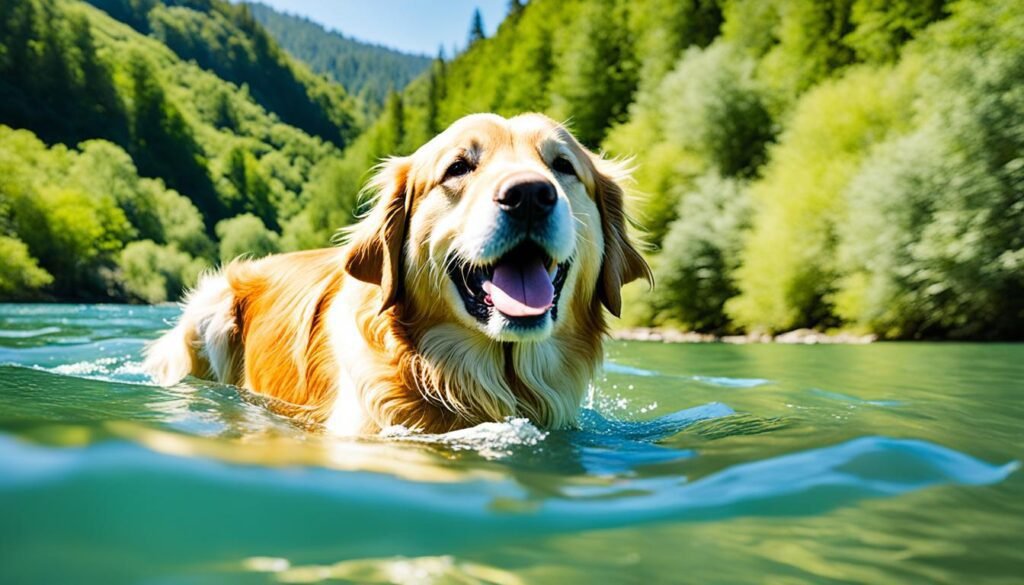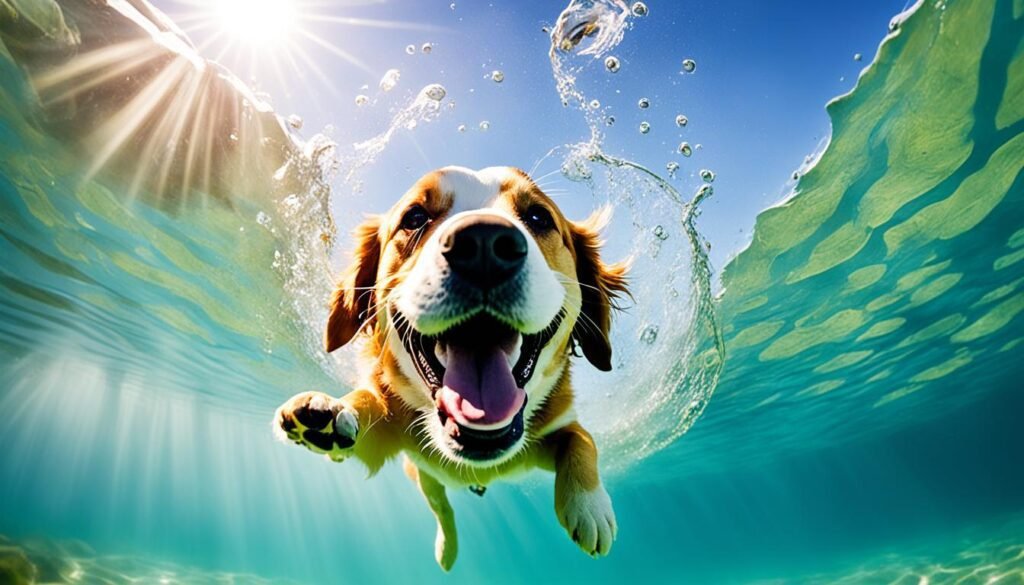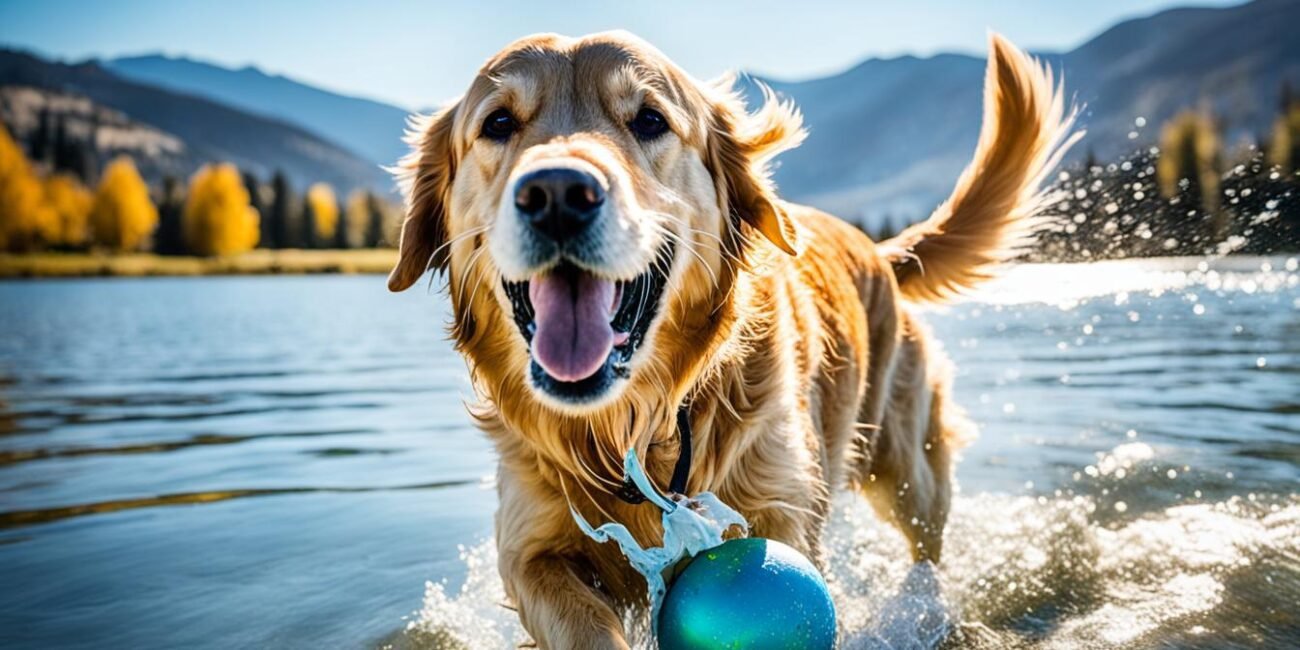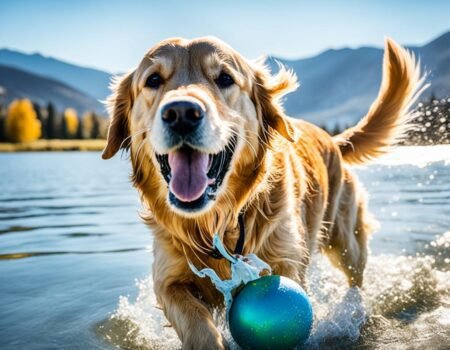“Dogs are not our whole life, but they make our lives whole.” – Roger Caras
Welcome to Summer 2024, where the sun shines brightly and the days are filled with endless possibilities. As we embrace the warm weather and plan our outdoor adventures, it’s important to consider the well-being of our beloved canine companions. One activity that often comes to mind during summer is swimming, as it provides a refreshing and enjoyable way to beat the heat. But how much should our furry friends swim? Let’s dive into the topic of dog swimming and uncover some guidelines to ensure the safety and health of our canine pals.
Key Takeaways:
- Swimming is a great exercise for dogs and can help keep them healthy and fit.
- It’s important to swim your dog in a safe and comfortable manner to prevent risks such as overheating and drowning.
- The frequency and duration of swimming for dogs may vary based on their breed, age, and health.
- Some dogs naturally enjoy swimming more than others, so it’s essential to consider your dog’s preferences and limitations.
- Swimming is an excellent low-impact activity for dogs with arthritis, providing pain relief and improved mobility.
The Benefits of Swimming for Dogs
Swimming is a low-impact activity that offers numerous benefits to dogs of all ages. Not only does it provide a fun and enjoyable form of exercise, but it also contributes to their overall health and well-being. Let’s dive into some of the reasons why swimming is great for dogs.
1. Low-Impact Activity
Swimming is a low-impact exercise that puts minimal stress on a dog’s joints. This makes it an excellent option for dogs with joint conditions, such as arthritis or hip dysplasia. Unlike high-impact activities like running or jumping, swimming allows dogs to engage in physical activity without placing excessive strain on their bodies.
2. Muscle Building and Fitness
Swimming engages the muscles in a dog’s entire body, providing an excellent full-body workout. As dogs paddle their way through the water, they work their leg muscles, core, and even their upper body. Regular swimming sessions can help dogs build strength, improve endurance, and maintain a healthy weight.
3. Coat Health
Swimming can help keep a dog’s coat in excellent condition. The water acts as a natural cleanser, washing away dirt and debris, which can contribute to a healthier and shinier coat. Additionally, swimming stimulates the skin and improves blood circulation, promoting a healthier coat from the inside out.
4. Cooling Off in the Summer
Swimming provides a fantastic way for dogs to cool off on hot summer days. As dogs paddle and splash in the water, their body temperature lowers, offering relief from heat and preventing overheating. It’s important to remember that dogs can’t regulate their body temperature as efficiently as humans, making swimming an essential activity during scorching summer months.
5. Mental Stimulation and Emotional Well-being
Swimming is not only physically beneficial but also mentally stimulating for dogs. The sensation of being in the water, the opportunity to explore and interact with their surroundings, and the overall enjoyment they experience can have positive effects on their mental and emotional well-being. Swimming can help alleviate stress, anxiety, and even provide a bonding experience between dogs and their owners.
Let’s summarize the benefits of swimming for dogs in a table:
| Benefits of Swimming for Dogs |
|---|
| Low-impact exercise for joints |
| Full-body muscle building and fitness |
| Promotes healthy coat condition |
| Efficient way to cool off in hot weather |
| Provides mental stimulation and emotional well-being |
As you can see, swimming offers a wide range of benefits for dogs, from physical fitness and coat health to mental stimulation and cooling off in the summer. Whether it’s in a pool or the great outdoors, swimming is a fantastic addition to your dog’s exercise routine.
The Risks of Dog Swimming
While swimming has many benefits for dogs, it is important to be aware of the risks involved. Dogs can easily overheat and become exhausted when swimming for too long, so it is important to provide regular breaks and access to fresh water. Supervision is also crucial to prevent drowning. It is important to ensure that your dog is always supervised while swimming to prevent any accidents.
Swimming poses certain risks for dogs, including the dangers of overheating, exhaustion, and drowning. Dogs can quickly overheat due to the physical exertion and exposure to the sun while swimming. Overheating can lead to heatstroke, which is a life-threatening condition that requires immediate medical attention.
It is essential to keep an eye on your dog’s behavior during swimming sessions. Signs of overheating include excessive panting, drooling, fatigue, and difficulty breathing. If you notice any of these symptoms, it’s crucial to remove your dog from the water and provide them with a cool, shaded area.
Exhaustion is another risk associated with dog swimming. Dogs can easily become fatigued when swimming for extended periods, especially if they are not accustomed to regular exercise. It is important to monitor your dog’s energy levels and provide frequent breaks to prevent exhaustion.
Always remember that even strong swimmers can become exhausted, so it’s important to gradually increase your dog’s swimming duration and provide rest periods to avoid pushing them too hard.
Additionally, drowning is a significant concern when it comes to dog swimming. While dogs possess natural swimming instincts, accidents can still happen. It is crucial to supervise your dog at all times while swimming, even if they are strong swimmers. Never leave your dog unattended in the water, whether it’s a pool, lake, or any other body of water.
Be vigilant and ensure that your dog has easy access to exit points in case of any emergency while swimming.
By being aware of these risks and taking necessary precautions, you can ensure that your dog stays safe and enjoys a positive swimming experience.
| Risks | Symptoms | Prevention |
|---|---|---|
| Overheating | Excessive panting, drooling, fatigue, difficulty breathing | Provide shade, rest, and fresh water; monitor for signs of overheating |
| Exhaustion | Lack of energy, difficulty swimming, struggling to stay afloat | Monitor energy levels, take frequent breaks, gradually increase swimming duration |
| Drowning | Inability to swim, panic, struggling to stay above water | Supervise at all times, provide easy exit points, never leave unattended |
The Best Times to Swim with Your Dog in the Open Water or a Pool
When it comes to swimming with your dog, finding the best times to enjoy the water can depend on various factors such as the dog’s breed, age, and health. Most dogs can safely swim several times a week without any issues, but it’s essential to consider their limitations and ensure their comfort and safety.
Before taking your dog swimming, it’s important to assess their swimming abilities and overall health. Some dogs may not be strong swimmers or have certain health conditions that can limit their ability to swim. In these cases, consulting with a veterinarian is crucial to determine the best swimming practices for your furry friend.
Whether you plan to swim with your dog in open water or a pool, there are a few key considerations to keep in mind. Open water, such as lakes or rivers, may offer different challenges than a controlled pool environment, and understanding these differences is important for your dog’s safety.
When swimming with your dog in open water, it’s essential to be mindful of their swimming frequency and abilities. While some dogs are natural swimmers and can handle longer distances, others may tire quickly or struggle with certain swimming conditions. It’s important to closely observe your dog’s behavior and ensure that they are swimming within their comfort zone.
In a pool setting, you have more control over the swimming environment, making it easier to tailor the experience to your dog’s needs. However, swimming in a pool still requires monitoring and consideration of your dog’s limitations. Small pools may not provide enough space for larger breeds to swim freely, while deeper pools may present challenges for smaller dogs.
Remember to always be attentive to your dog’s signals during swimming sessions. Signs of fatigue, discomfort, or distress should be taken seriously, and breaks should be provided accordingly. Additionally, make sure to provide fresh drinking water for your dog to stay hydrated throughout the swimming activity.
Swimming is a fantastic way for dogs to exercise and have fun, but it’s important to approach it with caution and prioritize your dog’s safety and well-being. By understanding your dog’s swimming frequency, limitations, and preferences, you can ensure that their swimming experiences are enjoyable and beneficial.
So, whenever you plan to take your dog swimming, be it in open water or a pool, remember to consider their individual needs and consult with your veterinarian if you have any concerns. With proper care and attention, swimming can be a wonderful activity that strengthens the bond between you and your furry companion, while also keeping them healthy and happy.
Remember These Tips for a Safe and Enjoyable Swim:
- Know your dog’s swimming abilities and limitations
- Consult with a veterinarian if your dog has health issues or is not a strong swimmer
- Monitor your dog closely during swimming sessions
- Provide regular breaks and fresh drinking water
- Adjust the swimming environment to suit your dog’s size and comfort level
Dogs Enjoy Swimming and it’s a Great Workout
Some dogs naturally enjoy swimming more than others. If your dog loves the water and seems to have endless energy when swimming, they can swim more often than other dogs. However, if your dog seems tired easily or doesn’t seem to enjoy swimming as much, it may be best to limit their swimming sessions. The frequency of swimming for your dog should be based on their individual energy levels and overall enjoyment.
Swimming is not only a fun activity for dogs, but it also provides them with a great workout. Just like humans, dogs need regular exercise to stay healthy and maintain their energy levels. Swimming is a low-impact exercise that helps dogs build strength, improve endurance, and burn calories. It works the muscles without putting excessive stress on their joints, making it an ideal form of exercise for dogs of all ages and sizes.
When dogs swim, they engage multiple muscle groups, including their legs, chest, and core. This helps to improve their overall fitness and muscle tone. Swimming also helps to keep their cardiovascular system healthy, improving their heart and lung function. Additionally, swimming can provide mental stimulation for dogs, as they have to navigate through the water and use their senses to stay afloat.
“Just like humans, dogs need regular exercise to stay healthy and maintain their energy levels.”
In addition to the physical benefits, swimming can have a positive impact on a dog’s mental well-being. The water provides a calming environment for dogs, allowing them to release any pent-up energy or stress. It can also help to alleviate anxiety in some dogs, as the buoyancy of the water can make them feel more secure and relaxed. Swimming can be a great bonding activity between dogs and their owners, fostering trust and strengthening their relationship.
Swimming Tips:
- Ensure that your dog is comfortable with swimming and introduce them to the water gradually.
- Always supervise your dog while swimming to ensure their safety.
- Provide frequent breaks and access to fresh water to prevent dehydration.
- Pay attention to your dog’s energy levels and adjust their swimming frequency accordingly.
- Monitor their behavior and watch for any signs of fatigue or distress.
Remember, swimming should be a positive and enjoyable experience for your dog. If they show signs of fear or discomfort, it’s important to respect their boundaries and find alternative forms of exercise that they will enjoy. Every dog is unique, so listen to their cues and tailor their swimming routine to their individual needs and preferences.
Get ready to dive into the fun and refreshing world of dog swimming, where your furry friend can enjoy a great workout while having a splashing good time!

Swimming is Great for Dogs with Arthritis
Swimming offers numerous benefits for dogs with arthritis, providing them with a low-impact exercise that helps relieve joint pain. When dogs swim, the buoyancy of the water reduces the stress on their joints, allowing them to move more freely and comfortably. This low-impact workout not only helps to ease pain but also improves mobility.
To illustrate the benefits of swimming for dogs with arthritis, consider the following table:
| Benefits of Swimming for Dogs with Arthritis | ||
|---|---|---|
| Low-impact exercise | Relieves joint pain | Improves mobility |
(Table: Benefits of Swimming for Dogs with Arthritis)
The frequency of swimming for dogs with arthritis depends on their overall health and the weather conditions. During warm weather, swimming daily may be suitable for healthy dogs. However, it is crucial to consult with a veterinarian to determine the best swimming schedule for a dog with arthritis, taking into account their individual needs and limitations.
By incorporating swimming into the routine of dogs with arthritis, we can provide them with an enjoyable and effective form of exercise that promotes joint pain relief and overall well-being.
How to Get Your Dog Started in Swimming
If your dog is new to swimming, introducing them to the water gradually and at their own pace is crucial to ensure their comfort and safety. Follow these steps to help your furry friend become a confident swimmer:
Step 1: Choose a suitable location
Select a calm and shallow body of water for your dog’s first swimming experience. It could be a calm beach, a pool with a gradual entry, or a designated dog swimming area.
Step 2: Use positive reinforcement
Encourage your dog with positive reinforcement, such as treats, praise, and affection, to create a positive association with swimming. Make them feel comfortable and assured in the water.
Step 3: Start with shallow water
Allow your dog to explore the shallow water first. Gradually lead them deeper as they become more comfortable. Let them get used to the sensation of being in the water and moving around.
Step 4: Use flotation aids, if needed
If your dog is hesitant or not a strong swimmer, consider using a flotation aid, such as a dog life jacket. This will give them extra buoyancy and confidence in the water.
Step 5: Keep swimming sessions short
During the initial training phase, keep swimming sessions short to prevent your dog from becoming overwhelmed or fatigued. Start with just a few minutes and gradually increase the duration as they become more comfortable.
Step 6: Supervise at all times
Always supervise your dog while they are swimming, especially during the early stages of training. This will ensure their safety and allow you to intervene if needed.
Remember, every dog is different, and some may take longer to become comfortable in the water. Patience, consistency, and positive reinforcement are key to helping your dog enjoy swimming.
With proper training and gradual introduction, your dog can become a confident and joyful swimmer, reaping the many benefits of this enjoyable activity.
Continue reading to discover the ideal swimming frequency for dogs based on their size and how long each swimming session should last.
Depending on the Dog’s Size
The frequency of swimming for your dog may depend on their size. Toy and small breeds can swim once or twice a week, while medium and large breeds can swim more frequently, up to three or four times a week. However, it is important to consider your individual dog’s preferences and limitations, as some dogs may simply not enjoy swimming regardless of their size.
If your dog belongs to a small breed, such as a Chihuahua or Pomeranian, swimming once or twice a week can be sufficient to provide them with exercise and enjoyment. Small dogs may tire more easily, so shorter swimming sessions with frequent breaks could be ideal. Pay attention to your dog’s energy levels and comfort in the water, ensuring that they do not become overwhelmed or exhausted.
Medium-sized breeds, like Beagles or Bulldogs, can benefit from swimming two to three times a week. These dogs often have a moderate energy level and can handle slightly longer swimming sessions. Monitor your dog’s response to swimming and adjust the frequency accordingly to ensure they remain comfortable and enthusiastic.
Large breeds, such as Labrador Retrievers or German Shepherds, are typically more active and may enjoy swimming three to four times a week. These dogs often have a higher endurance level and can handle longer swimming sessions. However, it’s important to consider your dog’s joint and muscle health, as larger breeds may be more prone to certain conditions. Consult with your veterinarian to determine the appropriate swimming frequency for your specific dog.
Here is a comparison table of swimming frequency based on dog size:
| Dog Size | Swimming Frequency |
|---|---|
| Small | Once or twice a week |
| Medium | Two to three times a week |
| Large | Three to four times a week |
Remember, the swimming frequency mentioned in the table is a general guideline and should be adjusted based on your dog’s individual needs, preferences, and overall well-being. It’s essential to monitor your dog’s response to swimming and ensure they have a positive experience. Always prioritize their safety and enjoyment when engaging in any physical activity, including swimming.
The Duration of the Swim
Swimming is a fantastic activity for dogs, providing them with exercise, mental stimulation, and an opportunity to cool off in the summer heat. However, it’s important to be mindful of the optimal swimming duration for dogs and the potential risks associated with swimming for too long.
While dogs can swim every day, it’s recommended to limit their swimming sessions to no more than 30 minutes at a time. This duration allows them to enjoy the benefits of swimming without putting themselves at risk for dehydration and heat exhaustion. Dogs regulate their body temperature primarily through panting, and prolonged swimming can lead to increased respiratory effort and potential overheating.
Additionally, it’s crucial to consider any existing health conditions your dog may have. Certain conditions, such as cardiovascular issues or respiratory problems, can be exacerbated by prolonged swimming. Always consult with your veterinarian if you have concerns about your dog’s swimming duration or if they have any pre-existing health conditions.
By keeping swimming sessions within the recommended time limits and considering your dog’s individual needs, you can ensure that their swimming experience remains safe, enjoyable, and beneficial to their overall well-being.
| Optimal Swimming Duration for Dogs | Risks of Swimming for Too Long |
|---|---|
| 30 minutes or less | Dehydration and heat exhaustion |
| Increase in respiratory effort | Exacerbation of pre-existing health conditions |
| Maintain body temperature safely | |
| Enjoy the benefits of swimming |
Remember, your dog’s safety and well-being should always be the top priority. Monitor their behavior and physical condition during and after swimming sessions, and make adjustments as necessary to ensure they have a happy and healthy swimming experience.

The risks of swimming for too long:
“Prolonged swimming sessions can lead to dehydration and heat exhaustion in dogs, putting their health at risk. It’s crucial to be mindful of the duration to prevent these potential complications.”
Reasons to Swim More or Less
The frequency of swimming for your dog depends on various factors that influence their swimming preferences and personal choices. Just like humans, dogs have their own unique preferences when it comes to swimming. Some dogs may be natural water enthusiasts, while others may not enjoy swimming as much. It’s essential to consider these factors to ensure that swimming remains a positive and enjoyable experience for your furry friend.
Factors Influencing Swimming Frequency
1. Breed: Certain dog breeds are more inclined to love swimming than others. Breeds like Labrador Retrievers, Golden Retrievers, Chesapeake Bay Retrievers, Newfoundlands, Portuguese Water Dogs, and Standard Poodles are known to be excellent swimmers. However, individual preferences may vary even within these breeds.
2. Age: Younger dogs may have a higher energy level and may enjoy swimming more frequently. Older dogs, on the other hand, may have different exercise needs and may prefer more relaxed swimming sessions.
3. Health and Fitness: Dogs with health issues, joint problems, or physical limitations may require swimming sessions that are more tailored to their specific needs. It’s important to consult with your veterinarian to determine the appropriate swimming frequency for your dog’s overall well-being.
Swimming Preferences and Personal Dog Choice
Just like humans, dogs have their own preferences and personalities. Some dogs may simply not enjoy swimming despite being capable of doing so. It’s important to observe your dog’s behavior and body language to understand their swimming preferences. If your dog shows enthusiasm and joy while swimming, it may be an indication that they would enjoy swimming more frequently. On the other hand, if your dog seems disinterested or anxious in the water, it’s best to respect their choice and limit their swimming sessions to avoid causing stress or discomfort.
Did You Know?
Dogs with webbed paws, such as Labrador Retrievers and Newfoundlands, have a natural advantage in the water. The webbing between their toes helps them paddle and swim more efficiently.
| Reasons to Swim More | Reasons to Swim Less |
|---|---|
|
|
Remember, the key is to prioritize your dog’s comfort and happiness. Pay attention to their cues, take into account their individual preferences, and adjust their swimming frequency accordingly. Whether your dog is a daily swimmer or an occasional splash enthusiast, make sure swimming remains a positive experience that enhances their overall well-being.
Find What Dog Breeds are Great Swimmers
When it comes to swimming, some dog breeds are natural water enthusiasts. These breeds are known for their excellent swimming abilities and are often used for water sports and activities. If you’re looking for a dog breed that loves the water, consider the following popular swimming dog breeds:
Labrador Retriever
The Labrador Retriever is not only a friendly and energetic companion but also an excellent swimmer. With their webbed paws and water-repellent coat, they are well-suited for both land and water activities. Labradors have a natural instinct for swimming and are often used as search and rescue dogs in water-based operations.
Golden Retriever
Similar to the Labrador Retriever, Golden Retrievers are known for their love of water and swimming skills. They have a dense water-resistant coat that keeps them warm while swimming and their friendly nature makes them great companions for swimming adventures. Golden Retrievers are often seen participating in activities like dock diving and water retrieving.
Chesapeake Bay Retriever
The Chesapeake Bay Retriever is a powerful and sturdy breed that excels in swimming. Originating from the Chesapeake Bay area, these retrievers were specifically bred to navigate and retrieve waterfowl in rough water conditions. With their dense double coat and unique swimming style, they are well-suited for swimming in cold water and challenging environments.
Newfoundland
The Newfoundland is a large and gentle breed with a strong swimming ability. Their webbed feet, thick coat, and muscular build make them excellent swimmers and water rescue dogs. Newfoundlands have a natural instinct to save and assist people in water, making them a popular choice for lifesaving operations.
Portuguese Water Dog
The Portuguese Water Dog is an athletic and intelligent breed that is well-suited for water activities. Bred to assist fishermen in Portugal, these dogs have a water-repellent coat and a strong swimming ability. They excel in activities like dock diving, water trials, and water rescue operations.
Standard Poodle
Don’t be fooled by their elegant appearance, Standard Poodles are excellent swimmers and water retrievers. They have a curly and non-shedding coat that repels water, making them well-suited to swim in various conditions. Standard Poodles are versatile athletes and can participate in water sports and activities with ease.
While these breeds are known for their swimming abilities, it’s important to remember that individual dogs within a breed may have different preferences and abilities when it comes to swimming. Always consider your dog’s comfort and safety when introducing them to water and engaging in swimming activities.
Swimming can be a fun and healthy activity for both you and your furry companion. Whether it’s a day at the beach, a dip in the pool, or exploring a lake, these swimming dog breeds are sure to make a splash!
Conclusion
Swimming can be a great activity for dogs, providing them with exercise and a chance to cool off in the summer. However, it is essential to prioritize safety and consider your dog’s individual needs and limitations. When swimming with your dog, always supervise them closely to prevent any accidents.
Remember to provide regular breaks and access to fresh water to prevent dehydration. Consulting with your veterinarian is also crucial to ensure you are following safe dog swimming practices. They can provide guidance on swimming frequency and duration based on your dog’s unique circumstances.
By following these guidelines, you can ensure that your dog has a safe and enjoyable experience while swimming in Summer 2024. Keep in mind that each dog is different, so it’s essential to tailor your approach based on your dog’s preferences and abilities. Let’s make dog swimming a fun and safe activity for all our furry friends!
FAQ
How much should my dog swim?
The frequency of swimming for dogs can vary depending on their breed, age, and health. Most dogs can safely swim several times a week without any issues. However, it is important to consider your dog’s limitations, such as their ability to swim long distances and their comfort level in different bodies of water. If your dog has health issues or is not a strong swimmer, it is important to consult with your veterinarian before taking them swimming.
What are the benefits of swimming for dogs?
Swimming is a low-impact activity that is easy on the joints of dogs, making it an ideal form of exercise for dogs of all ages. It helps them burn calories, build muscle, and keep their coat healthy. Swimming also provides a great way for dogs to cool off on hot summer days. It is especially beneficial for dogs who are overweight or obese, as it allows them to exercise without putting too much strain on their body.
What are the risks of dog swimming?
While swimming has many benefits for dogs, it is important to be aware of the risks involved. Dogs can easily overheat and become exhausted when swimming for too long, so it is important to provide regular breaks and access to fresh water. Supervision is also crucial to prevent drowning. It is important to ensure that your dog is always supervised while swimming to prevent any accidents.
When is the best time to swim with my dog?
The frequency of swimming for dogs may vary depending on their size. Toy and small breeds can swim once or twice a week, while medium and large breeds can swim more frequently, up to three or four times a week. However, it is important to consider your individual dog’s preferences and limitations, as some dogs may simply not enjoy swimming regardless of their size.
How much do dogs enjoy swimming and is it a good workout for them?
Some dogs naturally enjoy swimming more than others. If your dog loves the water and seems to have endless energy when swimming, they can swim more often than other dogs. However, if your dog seems tired easily or doesn’t seem to enjoy swimming as much, it may be best to limit their swimming sessions. The frequency of swimming for your dog should be based on their individual energy levels and overall enjoyment.
Is swimming beneficial for dogs with arthritis?
Swimming is an excellent form of exercise for dogs with arthritis and other joint issues. It provides a low-impact workout that helps to ease pain and improve mobility. The frequency of swimming for dogs with arthritis depends on their overall health and the weather conditions. Daily swimming may be suitable for healthy dogs during warm weather, but it is important to consult with a veterinarian for guidance on the best swimming schedule for a dog with arthritis.
How can I get my dog started in swimming?
If your dog is new to swimming, it is important to introduce them to the water gradually and at their own pace. Start by allowing them to explore shallow water and gradually move into deeper water as they become more comfortable. It is important to provide positive reinforcement and rewards during the training process to help your dog associate swimming with a positive experience.
How does the dog’s size affect their swimming frequency?
The frequency of swimming for your dog may depend on their size. Toy and small breeds can swim once or twice a week, while medium and large breeds can swim more frequently, up to three or four times a week. However, it is important to consider your individual dog’s preferences and limitations, as some dogs may simply not enjoy swimming regardless of their size.
How long should my dog swim at a time?
Dogs can swim every day, but it is important to limit their swimming sessions to no more than 30 minutes at a time. Swimming for longer periods can put dogs at risk for dehydration and heat exhaustion. It is also important to consider any existing health conditions your dog may have, as swimming may exacerbate certain conditions. Always consult with your veterinarian if you have any concerns about your dog’s swimming duration.
Why should I swim my dog more or less?
The frequency of swimming for your dog ultimately depends on their individual preferences and needs. Some dogs may love the water and want to swim every day, while others may only enjoy swimming occasionally. It is important to pay attention to your dog’s cues and adjust their swimming frequency accordingly. The key is to ensure that swimming is a positive and enjoyable experience for your dog.
What dog breeds are known for their swimming abilities?
There are several dog breeds that are known for their swimming abilities. Popular swimming dog breeds include Labrador Retrievers, Golden Retrievers, Chesapeake Bay Retrievers, Newfoundlands, Portuguese Water Dogs, and Standard Poodles. These breeds are often used for water sports and have natural swimming abilities. However, it is important to remember that individual dogs within a breed may have different preferences and abilities when it comes to swimming.
How can I conclude my dog’s swimming sessions?
Swimming can be a great activity for dogs, providing them with exercise and a chance to cool off in the summer. However, it is important to prioritize safety and consider your dog’s individual needs and limitations. Always supervise your dog while swimming, provide regular breaks and access to fresh water, and consult with your veterinarian for guidance on swimming frequency and duration. By following these guidelines, you can ensure that your dog has a safe and enjoyable experience while swimming in Summer 2024.







No Comment! Be the first one.